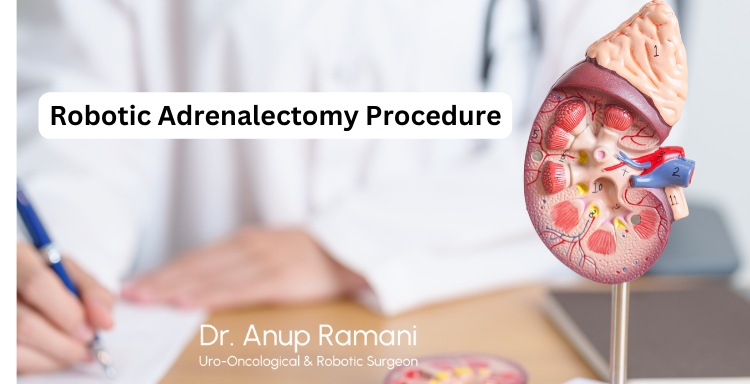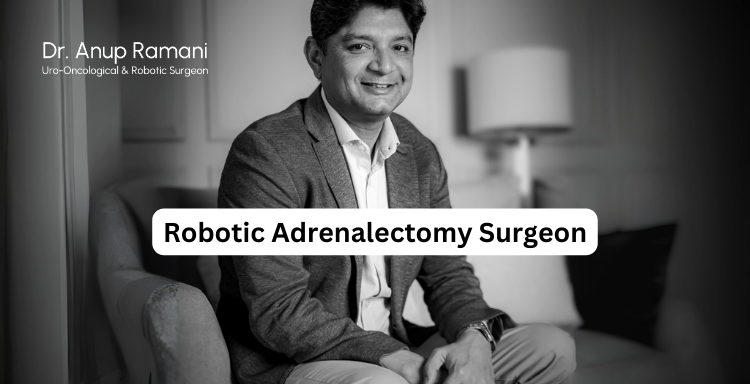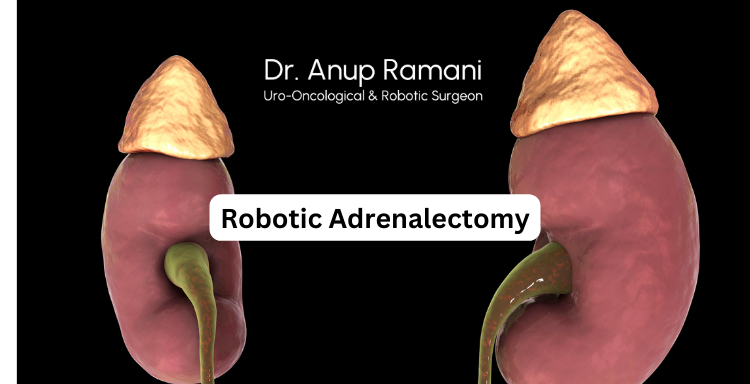Dr Anup Ramani @ Copyright 2024
By Dr. Anup Ramani
Facing surgery can be a daunting experience, but with the right preparation, the process can become much smoother and more manageable. Robotic adrenalectomy, a cutting-edge procedure for treating adrenal gland disorders, offers a Minimal invasive approach that reduces recovery time and improves surgical precision. Proper preparation is key to ensuring that the surgery goes smoothly and that you’re well on the road to recovery.
Understanding Robotic Adrenalectomy
What is Robotic Adrenalectomy?
Robotic adrenalectomy is a Minimal invasive surgical technique used to remove one or both adrenal glands, typically due to tumors or other adrenal disorders like hyperplasia. This surgery employs robotic technology, where a Robotic Adrenalectomy surgeon operates robotic arms through small incisions, allowing for enhanced precision and control compared to traditional open or laparoscopic surgery. Conditions commonly treated include adrenal tumors, pheochromocytomas, and adrenal adenomas.
Benefits of Robotic Surgery for Adrenal Gland Disorders
Robotic adrenalectomy offers several advantages over traditional surgery. First, because it is Minimal invasive, it requires only small incisions, leading to less pain, reduced blood loss, and a quicker recovery time. The robotic system provides the surgeon with better visualization and dexterity, which is especially useful when operating on delicate structures like the adrenal glands. Patients undergoing robotic surgery typically experience less scarring and can return to their daily lives faster.
Preoperative Preparation for Robotic Adrenalectomy
Initial Consultation and Evaluation
The first step in preparing for robotic adrenalectomy is a consultation with your Robotic Adrenalectomy surgeon. During this meeting, your medical history will be reviewed, and you’ll undergo imaging tests such as a CT scan or MRI to evaluate the size and location of the adrenal tumor. Your surgeon will explain the procedure, answer your questions, and discuss potential risks and benefits.
Pre-Surgery Instructions
In the days leading up to the surgery, your surgeon will provide specific instructions. These might include dietary restrictions, such as avoiding solid foods the night before the surgery and fasting the morning of. You’ll also be advised on managing any medications you’re currently taking. For instance, certain blood thinners may need to be temporarily stopped to reduce the risk of excessive bleeding during surgery. It’s essential to follow these instructions carefully to ensure the surgery proceeds without complications.
The Day Before Surgery
Final Preparations Before Robotic Adrenalectomy
On the day before your surgery, you’ll need to follow any eating and drinking restrictions provided by your surgeon. This usually means sticking to light, easily digestible meals and avoiding food entirely after midnight. Staying well-hydrated and getting a good night’s rest will help your body be in the best possible condition for the procedure.
Preparing Mentally and Emotionally
Preparing for surgery isn’t just about physical health—mental and emotional preparation is also important. It’s natural to feel anxious before any surgery, but talking to your surgeon about your concerns can help ease some of that stress. Practicing relaxation techniques, such as deep breathing or meditation, can also be beneficial. Understanding what to expect can significantly reduce anxiety and help you approach the procedure with confidence.
The Robotic Adrenalectomy Procedure
What Happens During the Surgery?
During robotic adrenalectomy, the patient is placed under general anesthesia. The surgeon will make a few small incisions in the abdomen to insert robotic instruments and a high-definition camera. From a console, the surgeon will control the robotic arms to remove the adrenal gland or tumor with high precision. The entire procedure typically lasts between two to four hours, depending on the complexity of the case.
Duration of the Procedure
The length of the surgery depends on several factors, including the size and location of the tumor. However, thanks to the enhanced precision of robotic technology, the procedure is generally faster than traditional open surgery. The shorter surgery time also means a quicker recovery for most patients.

Postoperative Care and Recovery
What to Expect After Robotic Adrenalectomy
After the procedure, you’ll spend some time in a recovery room while the anesthesia wears off. Most patients stay in the hospital for one to two days following surgery. You may experience some discomfort at the incision sites, but this is typically mild and can be managed with over-the-counter pain medications. Your surgeon will provide specific instructions on how to care for your incisions and what activities to avoid during the first few weeks of recovery.
Recovery Timeline
Recovery from robotic adrenalectomy is generally faster than traditional surgery. Most patients can resume light activities within a week, with full recovery typically taking around two to four weeks. Your surgeon will provide detailed guidelines on when it’s safe to return to work, exercise, and other daily routines. During this time, it’s essential to avoid strenuous activity to allow your body to heal properly.
Monitoring and Follow-Up Care
Post-Surgery Monitoring and Follow-Ups
Regular follow-up appointments are crucial after robotic adrenalectomy. These appointments allow your Adrenal Gland Surgeon in India to monitor your recovery and ensure that your adrenal glands are functioning correctly. Blood tests may be conducted to check hormone levels, particularly if one of the adrenal glands was removed. Follow-ups also provide an opportunity to address any concerns or complications that may arise post-surgery.
Long-Term Health After Robotic Adrenalectomy
Maintaining long-term adrenal health involves regular monitoring of hormone levels and lifestyle changes, such as managing stress and maintaining a balanced diet. Your surgeon will provide specific recommendations based on your condition. In some cases, patients may require hormone replacement therapy if both adrenal glands are removed.
Choosing the Right Surgeon and Facility
Finding a Qualified Robotic Adrenalectomy Surgeon
Choosing the right surgeon is critical to the success of your surgery. Look for a Robotic Adrenalectomy surgeon with extensive experience in robotic procedures. The surgeon’s expertise in both adrenal gland disorders and robotic technology will ensure that you receive the best possible care. Many leading Adrenal Gland Surgeons in India have specialized training in these advanced techniques, making India a top destination for adrenal gland surgery.

Availability of Robotic Adrenalectomy in India
India is home to world-class hospitals equipped with the latest robotic technology, particularly in cities like Mumbai. Patients seeking Adrenal Gland Surgery in Mumbai or other major cities in India will find a wide range of top-tier healthcare facilities that offer robotic adrenalectomy at an affordable cost. This combination of quality care and affordability has made Adrenal Gland Surgery in India a popular choice for both domestic and international patients.
Patient Testimonials and Experiences
Real Patient Stories
Many patients who have undergone robotic adrenalectomy report positive outcomes and faster recoveries. For example, patients treated in Mumbai and other parts of India have shared stories of returning to their normal lives within a few weeks of surgery, with minimal scarring and discomfort. These testimonials often highlight the skill of their Robotic Adrenalectomy surgeons and the quality of care they received at top Indian hospitals.
Conclusion
Robotic adrenalectomy offers a Minimal invasive solution for those suffering from adrenal gland disorders. Proper preparation-both physical and mental-can significantly improve the surgery’s outcome and make recovery smoother. Choosing the right surgeon, following pre-surgery instructions, and understanding what to expect during recovery are all key steps in ensuring a successful procedure.
FAQs - Robotic Adrenalectomy
What should I do the day before robotic adrenalectomy?
Follow your surgeon’s instructions closely. This typically includes fasting, staying hydrated, and getting plenty of rest before surgery.
How long is the recovery period after robotic adrenalectomy?
Most patients recover within two to four weeks, although light activities can usually be resumed within a week.
What are the risks of robotic adrenalectomy?
While robotic adrenalectomy is generally safe, there are risks such as bleeding, infection, and damage to nearby organs, although these risks are lower compared to traditional surgery.
Can robotic adrenalectomy be done in India?
Yes, robotic adrenalectomy is widely available in India, with many top hospitals in cities like Mumbai offering this advanced procedure.
How do I choose the best robotic adrenalectomy surgeon?
Look for a surgeon with specialized experience in robotic adrenalectomy and a strong track record of successful outcomes. Consider patient testimonials and the reputation of the hospital where the surgery will be performed.
Table of Contents
Recent Blogs
Best Uro-Oncological surgeon
Specialist in India for Robotic Surgery
MCh, DNB, MS, DNB
Dr. Anup Ramani
CONTACT
Uro-Oncologist in India,
Best Robotic Surgeon for Uro Oncology Surgery
1407, One Lodha Place Next to World Towers Senapati Bapat Marg, Worli, Mumbai. 400013.
Dr Anup Ramani @ Copyright 2024 – Website Maintenance & SEO by Webmasterindia
- Partial penectomy is done in cases where glans and distal penis is involved with carcinoma.
- Partial penectomy is a type of organ-preserving surgery. Preservation of sexual and micturational function depends on the surgical dissection and reconstruction of residual urethra.
- Patients who develop stones in the kidney or ureter, often experience severe pain.
- This condition usually needs a procedure to remove the kidney stones.
- This procedure is called ureteroscopy and is performed very commonly.
- It does not require any cuts and hence it is painless.
- The procedure is performed with an endoscope inserted through the penis under spinal anesthesia.
- The scope is inserted through the penis into the kidney and stones are dissolved with a laser.
- The procedure takes about 40-50 minutes.
- A catheter (urine pipe) is kept after the procedure to drain the bladder. A stent is kept in the kidney at the same time.
- Patient is mobile and walking in the room the same evening.
- Hospital stay is one night and patient is discharged the next day after removal of the catheter.
- Patient has to come back after six weeks to remove the stent in the kidney.
- Patients can resume office a week after surgery and heavy activities like running, weight lifting, a month after the procedure.
- We offer fixed packages for this procedure which can be obtained by calling our helpline +91 9967666060.
- Men with an enlarged prostate, which is a normal ageing changes, often experiencing difficulty passing urine. This condition usually needs a procedure to trim the prostate and relieve the blockage.
- This procedure is called TURP and is performed very commonly.
- It does not require any cuts and hence it is painless.
- The procedure is performed with an endoscope inserted through the penis under spinal anaesthesia.
- The overgrown prostate is dissolved with a laser bloodlessly.
- The procedure takes about 40 minutes.
- A catheter (urine pipe) is kept after the procedure to drain the bladder.
- Patient is mobile and walking in the room the same evening.
- Hospital stay is two nights and patient is discharged with the catheter, which is removed after 4 days.
- Patients can resume office a week after surgery and heavy activities like running, weight lifting, a month after the procedure.
- We offer fixed packages for this procedure which can be obtained by calling our helpline +91 9967666060.
-
Robotic adrenalectomy is a sophisticated, complex surgery and it is very important that an experienced surgeon performs this surgery to avoid major complications.
-
Once the anesthesia is done, and patient positioned, three micro cuts (3mm each) are made in the patient’s abdomen.
-
The arms of the Da Vinci robot are connected to the cuts via ports (tubes).
-
Dr. Ramani then sits in the controlling console to perform the surgery.
-
On an average, a robotic adrenalectomy takes one hour.
-
The surgery is almost completely bloodless and there has never been any need to transfuse blood after surgery.
-
A urine catheter and bag to drain the bladder is inserted during surgery.
-
A tiny drain pipe may be inserted in the surgical side of the abdomen, connected to a bag.
-
Patient is kept nil-by-mouth the day of the surgery, with IV fluids. Sips of water are started the next day and solid food by day three.
-
The drain pipe, if kept, is removed in the room on day 2 after surgery.
-
The catheter is removed on day two after surgery.
-
Total hospital stay for robotic adrenalectomy is 4 nights (including night before surgery).
-
Post discharge, a doctor from the surgical team visits the patient at home/ hotel room once every day.
On the day of discharge, patient is totally self-sufficient. They are able to walk freely without any pain, dress themselves, shower, toilet and they do not need to hire any nurse or help at home. Almost all patients are back to work within 2 weeks of surgery.
Heavy activities like running, weight lifting can be resumed after a month
Follow up after an adrenalectomy is in the form of CT scans, once a year for 5 years.
Local patients usually meet Dr. Ramani after two weeks to discuss report.Outstation patients are counselled on a phone consultation.
- Dr. Ramani is one of the very few surgeons in India who has the expertise to perform a robotic surgery for bladder cancer, which includes removing the urinary bladder and reconstructing a new bladder robotically.
- Robotic radical cystectomy is an extremely sophisticated, complex surgery and it is very important that an experienced surgeon performs this surgery to avoid major complications.
- Once the anaesthesia is done, and patient positioned, six micro cuts (3mm each) are made in the patient’s abdomen.
- The arms of the Da Vinci robot are connected to the cuts via ports (tubes).
- Dr. Ramani then sits in the controlling console to perform the surgery.
- On an average, a robotic radical cystectomy with an ileal conduit takes 3-4 hours.
- The surgery is almost completely bloodless and there has never been any need to transfuse blood after surgery.
- A urine catheter and bag to drain the new bladder is inserted during surgery.
- Two tiny drain pipe in inserted in the surgical side of the abdomen, connected to a bag.
- Patient is kept nil-by-mouth for 4 days after surgery with IV supplementation of patient’s daily requirements of calories, fats, carbohydrates, proteins and electrolytes.
- The drain pipes are removed in the room on day 3-5 after surgery.
- Total hospital stay for radical cystectomy is 8 nights (including night before surgery).
- Post discharge, a doctor from the surgical team visits the patient at home/ hotel room once every day.
- On the day of discharge, patient is totally self-sufficient. They are able to walk freely without any pain, dress themselves, shower, toilet and they do not need to hire any nurse or help at home.
- Almost all patients are back to work within 6 weeks of surgery. Heavy activities like running, weight lifting can be resumed after two months.
Follow up after a radical a cystectomy is in the form of CT scans, once a year for 5 years.
Histopathology report: Local patients usually meet Dr. Ramani after two weeks to discuss report.
Outstation patients are counselled on a phone consult. Depending on the report, patient may or may not need chemotherapy after surgery.
If chemo is needed, patients may choose to get it done with a medical oncologist of their choice or avail the services of one of the four medical oncologists on our team.
- Robotic partial nephrectomy is a sophisticated, complex surgery and it is very important that an experienced surgeon performs this surgery to avoid major complications. Robotic radical (total) nephrectomy is
- relatively easier but still requires significant experience to consistently deliver results.
- Once the anaesthesia is done, and patient positioned, five micro cuts (3mm each) are made in the patient’s abdomen.
- The arms of the Da Vinci robot are connected to the cuts via ports (tubes).
- Dr. Ramani then sits in the controlling console to perform the surgery.
- On an average, a robotic radical nephrectomy takes one hour and a robotic partial nephrectomy takes about an hour and half.
- The surgery is almost completely bloodless and there has never been any need to transfuse blood after surgery.
- A urine catheter and bag to drain the bladder is inserted during surgery.
- A tiny drain pipe in inserted in the surgical side of the abdomen, connected to a bag.
- Patient is kept nil-by-mouth the day of the surgery, with IV fluids. Sips of water are started the next day and solid food by day three.
- The drain pipe is removed in the room on day 3 after surgery. The catheter is removed on day two after surgery.
- Total hospital stay for radical/partial nephrectomy is 4 nights (including night before surgery).
- Post discharge, a doctor from the surgical team visits the patient at home/ hotel room once every day.
- On the day of discharge, patient is totally self- sufficient.
- They are able to walk freely without any pain, dress themselves, shower, toilet and they do not need to hire any nurse or help at home.
- Almost all patients are back to work within 2-3 weeks of surgery.
- Heavy activities like running, weight lifting can be resumed after a month.
- Follow up after a radical/partial Nephrectomy is in the form of CT scans, once a year for 5 years.
- Local patients usually meet Dr. Ramani after two weeks to discuss report.
- Outstation patients are counselled on a phone consultation.

